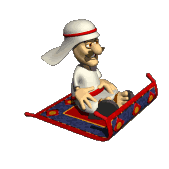There is nowhere in the world where the art of batik has been developed to the highest standards as in the island of Java in Indonesia. All the raw materials for the process are readily available - cotton and beeswax and many plants from which the dyes are made.
It is not known when the batik was first made but the traditional skills were particularly well developed over hundreds of years in Central Java around Yogyakarta and Solo under the patronage of the Sultan and his court. Designs were copies and in some cases the cloths could only be used by certain people or on certain occasions. The royal families had their own proscribed designs. On the coast designs were developed differently, influenced by settlers from China, the Dutch colonists and traders from India and Arabia.
Two methods of applying wax are used.
| 1 | The cloth is hung over the frame and the design is drawn on with a canting, a small copper cupped spout which is attached to a bamboo or wooden handle. The canting is dipped into a pot of hot wax and then allowed to flow through the spout on to the fabric. On thicker fabrics the waxing is carried out on both sides. This process is carried out by the women. |

| 2 | The cloth is stretched on to long tables and a cap or copper stamping tool is used. This is dipped into a pan of hot wax and pressed on to the fabric. This enables the design to be repeated many times and is usually done on both sides of the fabric by men. This is a much faster method of wax application. |

The traditional dyes used are deep indigo blues and soga browns and these are still the characteristic colours for work in central Java. Towards the end of the 19th century chemical dyes were introduced in the coastal regions and as a result of this the colours are usually brilliant and more varied.
The final hand made lengths of cloth, known as Tulis, may take several months to produce and are consequently very expensive. Everywhere in Indonesia people still wear clothing made from batik cloth and the tourist industry has opened up a new market for cheap batik clothing and pictures.


Tidak ada komentar:
Posting Komentar